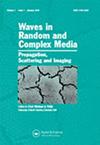随机介质中部分相干电磁波束的四阶矩分析
3区 物理与天体物理
Q1 Engineering
引用次数: 0
摘要
摘要提出了在源部分相干情况下电磁波波束四阶矩的表征理论。部分相干随机源采用高斯-谢尔模型。当波长远小于源的相关半径、源的光束半径和介质的相关长度(它们本身远小于传播距离)时,考虑了白噪声傍轴状态。复振幅场可以用Itô-Schrödinger方程来描述。该方程给出了波场各阶矩的封闭演化方程,这里考虑了四阶矩方程。在闪烁状态下(光源的相关半径与介质的相关半径同阶,但光束半径要大得多),对一般的四阶矩方程进行了显式求解,并给出了强度协方差函数的表征。强度协方差函数的形式来源于与二阶波矩相关的维格纳分布的输运方程的解。偏振波的四阶矩结果用于部分相干源成像的应用。关键词:随机介质电磁波多重scatteringSchrödinger方程高斯-谢尔模型闪烁源成像披露声明作者未报告潜在利益冲突。补充资料jg的经费由国家研究机构根据第5号赠款提供支助。ANR-19-CE46-0007(项目ICCI)和空军科学研究办公室,批准FA9550-22-1-0176。KS由美国空军科学研究办公室拨款(FA9550-22-1-0176)和美国国家科学基金会拨款(DMS-2010046)支持。本文章由计算机程序翻译,如有差异,请以英文原文为准。
Fourth-order moments analysis for partially coherent electromagnetic beams in random media
AbstractA theory for the characterization of the fourth-order moment of electromagnetic wave beams is presented in the case when the source is partially coherent. A Gaussian–Schell model is used for the partially coherent random source. The white-noise paraxial regime is considered, which holds when the wavelength is much smaller than the correlation radius of the source, the beam radius of the source, and the correlation length of the medium, which are themselves much smaller than the propagation distance. The complex wave amplitude field can then be described by the Itô-Schrödinger equation. This equation gives closed evolution equations for the wave field moments at all orders and here the fourth-order moment equations are considered. The general fourth-order moment equations are solved explicitly in the scintillation regime (when the correlation radius of the source is of the same order as the correlation radius of the medium, but the beam radius is much larger) and the result gives a characterization of the intensity covariance function. The form of the intensity covariance function derives from the solution of the transport equation for the Wigner distribution associated with the second-order wave moment. The fourth-order moment results for polarized waves are used in an application for imaging of partially coherent sources.Keywords: Random mediaelectromagnetic wavesmultiple scatteringSchrödinger equationGauss–Schell modelscintillationsource imaging Disclosure statementNo potential conflict of interest was reported by the author(s).Additional informationFundingJG was supported by the Agence Nationale pour la Recherche under Grant No. ANR-19-CE46-0007 (project ICCI), and Air Force Office of Scientific Research under grant FA9550-22-1-0176. KS was supported by the Air Force Office of Scientific Research under grant (FA9550-22-1-0176) and the National Science Foundation under grant (DMS-2010046).
求助全文
通过发布文献求助,成功后即可免费获取论文全文。
去求助
来源期刊

Waves in Random and Complex Media
物理-物理:综合
自引率
0.00%
发文量
677
审稿时长
3.0 months
期刊介绍:
Waves in Random and Complex Media (formerly Waves in Random Media ) is a broad, interdisciplinary journal that reports theoretical, applied and experimental research related to any wave phenomena.
The field of wave phenomena is all-pervading, fast-moving and exciting; more and more, researchers are looking for a journal which addresses the understanding of wave-matter interactions in increasingly complex natural and engineered media. With its foundations in the scattering and propagation community, Waves in Random and Complex Media is becoming a key forum for research in both established fields such as imaging through turbulence, as well as emerging fields such as metamaterials.
The Journal is of interest to scientists and engineers working in the field of wave propagation, scattering and imaging in random or complex media. Papers on theoretical developments, experimental results and analytical/numerical studies are considered for publication, as are deterministic problems when also linked to random or complex media. Papers are expected to report original work, and must be comprehensible and of general interest to the broad community working with wave phenomena.
 求助内容:
求助内容: 应助结果提醒方式:
应助结果提醒方式:


